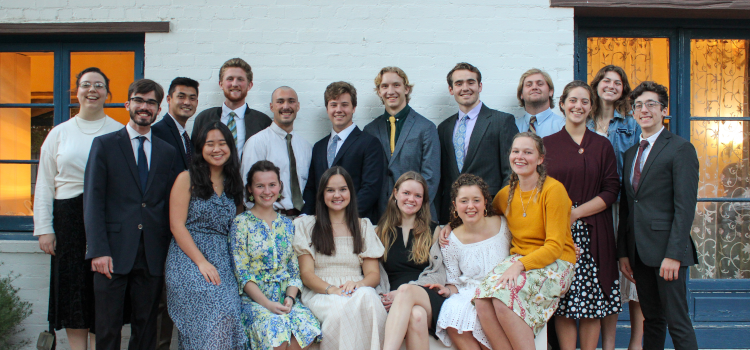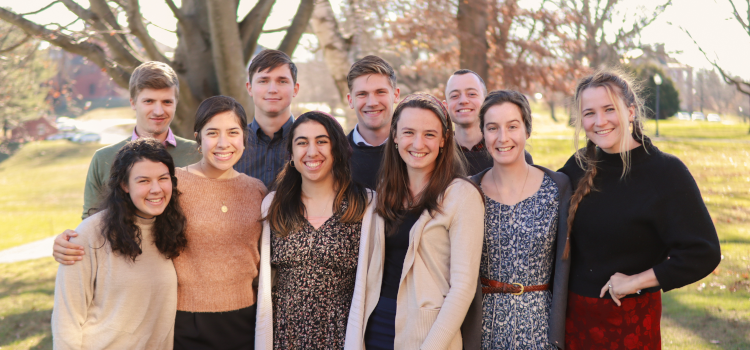- Home
-
About
 Fidelity & Excellence
Fidelity & ExcellenceThomas Aquinas College is unique among American colleges and universities, offering a faithfully Catholic education comprised entirely of the Great Books and classroom discussions.
-
A Liberating Education
 Truth Matters
Truth MattersTruth, and nothing less, sets men free; and because truth is both natural and supernatural, the College’s curriculum aims at both natural and divine wisdom.
-
A Catholic Life
 Under the Light of Faith
Under the Light of FaithThe intellectual tradition and moral teachings of the Catholic Church infuse the whole life of Thomas Aquinas College, illuminating the curriculum and the community alike.
-
Admission & Aid
 Is TAC Right for You?
Is TAC Right for You?Do you enjoy grappling with complex questions? Are you willing to engage in discussions about difficult concepts, with the truth as your ultimate goal?
-
Students & Parents
 Mind, Body & Spirit
Mind, Body & SpiritThere is always something to do at TAC — something worthwhile, something fulfilling, and something geared toward ever-greater spiritual and intellectual growth.
-
Alumni & Careers
 What Can You Do with a Liberal Education?
What Can You Do with a Liberal Education?Nothing speaks more to the versatility of the College’s academic program than the good that our alumni are doing throughout the Church and the world.
- Search
- Giving
Setting the Tone: Student Prefects Aid Peers in Pursuit of Wisdom

When new students arrive at Thomas Aquinas College, the first peers they meet, aside from their fellow freshmen, of course, are the prefects. These are the seniors, juniors, and sophomores who greet newcomers and their families at the welcome tables. They show the wide-eyed new arrivals to their rooms, place nametags on their doors, and host the Orientation icebreakers. They also lead the nightly prayers of consecration in residence halls and answer the inevitable questions about everything from class schedules to dress code.
As the freshmen soon discover, though, the prefects are more than a warm welcoming committee. “We embrace the curriculum and the life here as much as we can,” says Sophie Cummings (’23), head female prefect on the California campus, “and encourage others to do the same.”
“The academic program itself already ensconces the principle of self-governance in using the Discussion Method. That principle has also been established in life outside the classroom.”
Numbering 28 in all — 18 in California and 10 in New England —at least one can be found in each wing of every residence hall. As peer leaders, they play a vital role in the life of the College.
Pursuit of Wisdom
“The College was established for tutors and students to pursue wisdom together,” observes Dr. Travis Cooper, assistant dean for student affairs at TAC-California. “But we think of this pursuit as not happening only in the classroom.” Indeed, reading the same Great Books over four years and discussing them attentively with likeminded friends leads to a rich, spontaneous campus life that’s lived out in the residence halls, on the athletic fields, and at dances and on hikes.
“The prefects shape campus life by enthusiastically being involved in many of the activities we put on,” explains Dr. Patrick Gardner, Dr. Cooper’s New England counterpart. “They are involved in such a way that others can see how these activities are ordered toward the principal good we are pursuing.”
Theirs is a ministry of presence. “The prefects are confreres; consultants, sometimes, if students have questions or concerns,” says Dr. Cooper. But other times their duties are more subtle, involving little more than demonstrating — through the well-lived routines of everyday life — that the hard work of Catholic liberal education and the sacrifices it entails are worth it.
“Prefects don’t have to be the best students,” notes Dr. Gardner. “But they are model students in that they are deliberate about trying to live this life well and to ordering the various parts of their lives as students — their recreation, their socialization, their sports — toward the principal good.”
There are as many ways to meet this responsibility as there are prefects. “Not all students are the same,” reflects Michael Bishop (’23), head male prefect in California. “They’re going to have different strengths and weaknesses. Likewise, you get a variety of different kinds of prefects who display, if not the whole, at least aspects of what the College would like its students to be.”

Rules of Residence
Prefects are also responsible for enforcing the College’s Rules of Residence, which are designed to facilitate students’ pursuit of wisdom. “The academic program itself already ensconces the principle of self-governance in using the Discussion Method,” says Dr. Cooper. “That principle has also been established in life outside the classroom, in our system of student prefects.” Adds Mr. Bishop, “The fundamental thing comes down to having peers who are responsible for leading.”
The need for peer leadership is all the greater because some of the College’s rules are quite unlike those found at most other American colleges and universities. “Since the world does not always place a high value on the search for truth, the way students live at Thomas Aquinas College can seem excessive to someone looking in from the outside,” admits New England prefect Paul Habsburg (’24).
Some rules, such as the dress code, visually communicate the gravity of classroom discussions. Others ward off the ubiquitous distractions of modern life, such as restrictions on wi-fi access, cell phone usage, and watching movies. Still others — such as a nightly curfew, forbidding illicit alcohol and drug use, and prohibiting visits to residence halls of the opposite sex — combat the excessive or immoral behaviors that have hamstrung most American colleges since the 1960s.
These rules, however, promote a noble and ennobling culture that students come to cherish, even if they were initially skeptical. “The summer before I came to TAC was rough,” recalls California prefect William Deering (’24). “Covid had just started, and we were all back in our houses. I spent a lot of time reading articles and watching YouTube videos. But when I came to TAC, I couldn’t do that anymore — and, at first, I didn’t like that. Then about two months in, I realized I was a lot happier!”
Another junior in California, Paul Lessard, humorously recalls establishing new routines to improve his study habits. “I decided I was going to get to bed early, I was going to do all my homework, and I wasn’t going to stay out late,” he says. “And then it occurred to me: ‘Wait a minute — that’s just what the rules were trying to get me to do, anyway!’”
Cultivating Community
Modeling and monitoring campus life can be a tall order, but like anything difficult, it provides numerous avenues for growth. Their role as exemplars keeps prefects mindful of the common good they are pursuing as students. “We are here to help everyone remember that we all chose to follow this way of life,” says Irene Collins (NE’23), “that the rules are not something meant to hinder us but to help us.”
Importantly, the prefects’ responsibility as exemplars takes precedence over mere rule enforcement. “My role is to be present as a person whom people know and can come to for help — and less about the day-to-day enforcing of particular rules,” says Mr. Bishop. This responsibility, moreover, compels prefects and, in turn, the student body more broadly, to avoid falling into cliques. “Prefecting has made me talk to people I would probably never encounter otherwise,” says Miss Cummings. “Even if the first occasion is not a happy one, like enforcing dress code, I meet a lot more people, and I try to befriend them.”
Many prefects actively cultivate social life in their residence halls, from leading hallmates in praying the Rosary to informal discussion nights and off-campus outings. They help at campus events, lock the doors at night, and drive injured students to the emergency room. In countless ways large and small, the prefects contribute to building “a noble culture for the students, suitable to the intellectual life they’re living,” says John Metilly (’23), head male prefect on the New England campus.
“We are here to help everyone remember that we all chose to follow this way of life, that the rules are not something meant to hinder us but to help us.”
The community that the prefects help to create is a key ingredient in Thomas Aquinas College’s distinction among Catholic institutions of higher education. In 2019, Catholic Herald commended the College’s culture for promoting “properly ordered relations between the sexes that spark early and fruitful marriages.” Last year College Fix noted that, amidst the vocational crisis wracking the Church throughout the Western world, TAC “continues to produce priests, nuns and other religious vocations year after year.”
But while this intentional cultivation of a healthy moral and spiritual life sets Thomas Aquinas College apart from most other academic institutions, its purpose transcends merely creating a “safe space” for Catholic families to send their children. Rather, the culture which the prefects uphold is inseparable from the pursuit of wisdom under the light of faith, which has defined the College since its founding in 1971.
“To live in freedom is to live by the truth,” proclaims Thomas Aquinas College’s founding and governing document, A Proposal for the Fulfillment of Catholic Liberal Education. Fifty years later, this conviction remains the animating impulse of the College’s students. “I’m here looking for truth,” says Mr. Bishop. “Having a curriculum worth pursuing and the support of my peers, I’m beginning to find it.”

